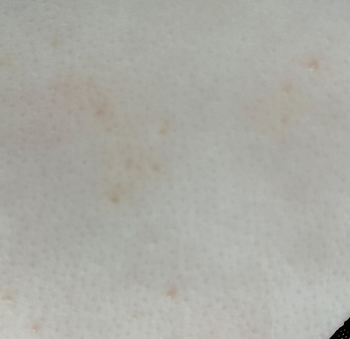Appearance of Beginning Stage Molluscum
18th Aug 2025
 Early Signs:
Early Signs:
- The first signs of molluscum contagiosum are small, firm bumps on the skin[1][2].
- These bumps are typically flesh-colored, white, or pink[1][2].
- They are usually smooth, shiny, and may resemble tiny pinheads or white pimples[3][4][2].
- The size is generally between 1 to 5 millimeters in diameter (about the size of a pinhead), but can sometimes grow larger[3][2][5].
- At this stage, the bumps are often painless and may appear singly or in small clusters[3][6].
Distinctive Features:
- In the very beginning, the bumps may not have a central dimple, but as they develop, a characteristic indentation or "dimple" in the center often appears, making them dome-shaped[1][4][2][5].
- The bumps can be skin-colored, pink, or white, and may look shiny or pearly[3][4][7][5].
- They can occur anywhere on the body but are most common on the torso, armpits, inner thighs, and crooks of the arms in children[1][2].
Summary Table: Early Molluscum Appearance
|
Feature |
Description |
|
Color |
Flesh-colored, white, or pink |
|
Shape |
Small, round, firm, smooth, shiny; sometimes like a white pimple |
|
Size |
1–5 mm (pinhead to pencil eraser size) |
|
Center |
May be flat or slightly indented (dimple develops later) |
|
Sensation |
Usually painless, may be itchy |
|
Location |
Torso, armpits, inner thighs, crooks of arms, face, neck |
Progression:
- Over time, these bumps may enlarge, develop a more obvious central dimple, and sometimes become itchy or inflamed, especially if scratched[1][4][2][6].
- As the infection progresses, the bumps may fill with a white core and the surrounding skin can become red or irritated, indicating the body is starting to fight the virus[4][2][6].
Key Visual Clues:
"At first, molluscum spots look like white pimples. They then become round, pearl-coloured lumps that have a white mark or indentation in the centre. They are usually one to five millimetres in size..."[3]
"When the bumps first appear, you usually see ones that are small, firm, pink, flesh-colored, or white. These bumps will likely get bigger."[1]
Conclusion
The beginning stage of molluscum contagiosum typically presents as small, smooth, shiny, flesh-colored, pink, or white bumps that may look like white pimples or pinheads. They are firm, usually painless, and may not initially have a central dimple, but this dimple often develops as the bumps grow[3][1][4][2][5].
- https://www.aad.org/public/diseases/a-z/molluscum-contagiosum-symptoms
- https://www.medicinenet.com/molluscum_contagiosum_facts/article.htm
- https://www.rch.org.au/kidsinfo/fact_sheets/molluscum/
- https://www.goodrx.com/conditions/skin-infection/molluscum-contagiosum-pictures-causes-treatment
- https://www.mayoclinic.org/diseases-conditions/molluscum-contagiosum/symptoms-causes/syc-20375226
- https://www.mollenol.com/molluscum-home-treatment/
- https://my.clevelandclinic.org/health/diseases/12175-molluscum-contagiosum
What Mollenol Can Do for Beginning Stage Molluscum
Mollenol is a topical, plant-based product marketed for the management of molluscum contagiosum, a common viral skin infection that starts as tiny, skin-colored or pearly bumps, often in clusters[1][2]. In the beginning stage, these bumps are generally small, contain little to no pus, and may be difficult to see[1].
How Mollenol Is Used in the Beginning Stage
- Symptom Relief and Moisturizing: Mollenol can be applied to beginning stage molluscum bumps to help reduce symptoms by providing moisture to the skin and counteracting inflammation[1][3].
- Application Guidance: For early, small bumps, a thin smear of Mollenol lotion should be applied 2–4 times per day directly to each bump. This should not be rubbed in, and the area should be kept covered with clothing if possible[2].
- Product Selection:
- Avoiding Spread: Early treatment aims to stop the spread of the virus, dry the bumps, heal lesions, and prevent re-infection[2].
What to Expect
- Symptom Minimization: Mollenol may help minimize inflammation and discomfort associated with early molluscum bumps[1][3].
- No Direct Antiviral Claim: While Mollenol is marketed to relieve symptoms and support healing, it is not an FDA-approved antiviral treatment for molluscum[4]. The only FDA-approved treatment is cantharidin, which must be administered by a healthcare professional[4].
- Natural Ingredients: Mollenol contains clove bud oil, coconut oil, and sandalwood oil, which are traditionally used for minor skin eruptions, mild eczema, and as antimicrobials[3].
Practical Considerations
- Medical Diagnosis: Ensure a doctor has diagnosed molluscum before starting any treatment[1].
- Do Not Apply to Broken Skin: Mollenol should not be used on open, scratched, or burst bumps due to risk of irritation or secondary infection[2].
- Monitor for Irritation: Start with a patch test, especially on children or sensitive skin, and discontinue if significant irritation occurs[2].
Clinical Perspective
- Self-Limiting Nature: Molluscum contagiosum often resolves on its own within 6–18 months, and routine treatment is not always necessary[5][6].
- Consultation Recommended: For persistent, widespread, or bothersome cases, or if you have concerns about treatment, consult a healthcare provider for guidance[7][4].
Summary:
Mollenol can be used in the beginning stage of molluscum to help reduce inflammation, moisturize the skin, and potentially limit the spread of the virus by managing early bumps. It is applied topically several times a day, with specific formulations for different ages and skin sensitivities. However, it is not a cure, and molluscum often resolves without treatment. Always seek medical advice for diagnosis and before starting any new treatment, especially in children[1][3][2].
⁂
- https://www.mollenol.com/molluscum-home-treatment/
- https://www.mollenol.com/content/Mollenol_How_to_Use.pdf
- https://www.mollenol.com/molluscum-contagiosum-treatment-for-children/
- https://www.fda.gov/consumers/consumer-updates/safely-treating-molluscum-common-skin-condition
- https://www.rch.org.au/kidsinfo/fact_sheets/molluscum/
- https://www.healthdirect.gov.au/molluscum-contagiosum
- https://www.aad.org/public/diseases/a-z/molluscum-contagiosum-treatment
